Caving
| Since my first caving trip, whilst on Scout Camp in 1982, I have tried to get underground as
often as possible and have now made over 120 trips lasting over 280 hours in total. The majority
of my experience lies in the Forest of Dean in the UK, although I have also made trips in South
Wales, the Mendips and Yorkshire, and I am always keen to try new caves and mines. When caving
in the Forest of Dean I usually stay with David "Sparky" Parker who is extremely knowledgeable
about the whole area. I am a member of the BCRA
(British Cave Research Association) and the GSS
(Gloucester Speleological Society). |
|
** **
Caving is a potentially dangerous pursuit but with the correct training, equipment and expertise can
be immensely fun and rewarding. If you fancy having a go then you should join a local club and never
go underground without proper training, equipment and expertise. |
Take nothing but pictures, leave nothing but footprints.
Pick from the list below to see information and photos on some my favourite caves and mines:
All photos on this page are © Oliver Hunter and may not be reproduced without prior permission
You can also look at my selection of caving links.
Brinchcombe Limestone Level
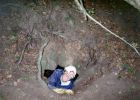
 Brinchcombe
Limestone Level is a small system near Ruspidge in the Forest of Dean and is perfectly suited for 'first-time'
and young cavers with a complete exploration taking a maximum of an hour and a half. The small entrance opens into
a short tunnel ending in a squeeze leading into the main system which consists of 1 main tunnel between 1 and 2
metres high and approximately 400m long. There is a 100m section of parallel passageway towards the far end of the
system which has 3 entry points but is has a sizeable amount of spoil left from the mining operation. There is a
vertical shaft leading up to the surface about halfway along the system which the miners could have used to access
the mine and which would also have provided some ventilation. It is possible to abseil down into the system via the
shaft but climbing up it is not recommended without ropes from the surface as some parts are very loose. Care should
be taken not to cross any taped sections and avoid any loose material on the walls/ceilings.
Brinchcombe
Limestone Level is a small system near Ruspidge in the Forest of Dean and is perfectly suited for 'first-time'
and young cavers with a complete exploration taking a maximum of an hour and a half. The small entrance opens into
a short tunnel ending in a squeeze leading into the main system which consists of 1 main tunnel between 1 and 2
metres high and approximately 400m long. There is a 100m section of parallel passageway towards the far end of the
system which has 3 entry points but is has a sizeable amount of spoil left from the mining operation. There is a
vertical shaft leading up to the surface about halfway along the system which the miners could have used to access
the mine and which would also have provided some ventilation. It is possible to abseil down into the system via the
shaft but climbing up it is not recommended without ropes from the surface as some parts are very loose. Care should
be taken not to cross any taped sections and avoid any loose material on the walls/ceilings.
The photos show Chris Horton in the entrance and Chris Whitehead (at back) with a party of Scouts at the far end of
the system. Since the photos were taken, the entrance has been (very poorly) surrounded with fences/barbed wire by the
Forestry Commission, making entry a slightly tricky affair. There are also plans to gate the entrance.
Dry/Wet Sink (Slaughter Stream Cave)
 I have only been on a few trips into this huge cave system. The entrance system is a huge affair, descending fixed
ladders before abseiling/electron laddering through a hole in the floor for the final 25m pitch. Helpfully, there
are permanent anchor points for ladders and ropes. Once inside there is a fair sized cavern, which leads into the
main streamway. This is quite impressive with the walls a couple of metres apart and about 10 metres high with a
substantial volume of water flowing through. There are some beautiful formations and features further in with 14km
of surveyed passages and the potential for a lot more. The photo shows James stood under a waterfall, from a trip
with John Linford and Anthony Copeland.
I have only been on a few trips into this huge cave system. The entrance system is a huge affair, descending fixed
ladders before abseiling/electron laddering through a hole in the floor for the final 25m pitch. Helpfully, there
are permanent anchor points for ladders and ropes. Once inside there is a fair sized cavern, which leads into the
main streamway. This is quite impressive with the walls a couple of metres apart and about 10 metres high with a
substantial volume of water flowing through. There are some beautiful formations and features further in with 14km
of surveyed passages and the potential for a lot more. The photo shows James stood under a waterfall, from a trip
with John Linford and Anthony Copeland.
The only minus point of this system is that there has been pollution present in the main streamway originating
from a sewerage pumping station a short way up the valley. The local council decided that Dry Sink would make an
ideal dumping point for excess flows and a pipeline was constructed in the mid 1970's with the message that it was
only for use as an "emergency storm water and sewerage overflow facility". Unfortunately it became very clear that
the system was being abused and in 1991, after many complaints, the NRA admitted "Malpractice at the pumping station"
and promised that it wouldn't happen again. In early 1997 the discharge was particularly bad and Central TV covered
the story as a lead item in a May bulletin. Local cavers contacted the Environment Agency, Welsh Water and their
local MP. The situation is much better these days but there remains a need monitor the situation.
Old Ham/New Dun
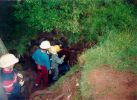
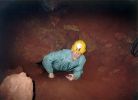 Old Ham Iron Ore Mine is situated in between Milkwall and Sling to the South of Coleford in the Forest of Dean.
The entrance is gated and one used to be able to obtain a key for approximately £5 a trip from the main office of the
Clearwell Caverns show cave just across the road. It provided an excellent trip for novices until it was discovered
that contamination, caused by chemical and waste dumping down the main shaft by Watkins Ltd. (a local transport
company) over many years, had reached critical levels in the lower levels of the mine. This forced mine safety
inspectors to temporarily close the mine. Greenpeace have been involved and there have been many discussions around
how to solve the problem, including drilling bore holes down to ventilate the lower levels. The upper levels are now
accessible again, subject to access agreement via Clearwell Caves, but so far there doesn't seem to be a solution in
sight. Click here to see the latest progress in the ongoing process of
understanding and rectifying the problem.
Old Ham Iron Ore Mine is situated in between Milkwall and Sling to the South of Coleford in the Forest of Dean.
The entrance is gated and one used to be able to obtain a key for approximately £5 a trip from the main office of the
Clearwell Caverns show cave just across the road. It provided an excellent trip for novices until it was discovered
that contamination, caused by chemical and waste dumping down the main shaft by Watkins Ltd. (a local transport
company) over many years, had reached critical levels in the lower levels of the mine. This forced mine safety
inspectors to temporarily close the mine. Greenpeace have been involved and there have been many discussions around
how to solve the problem, including drilling bore holes down to ventilate the lower levels. The upper levels are now
accessible again, subject to access agreement via Clearwell Caves, but so far there doesn't seem to be a solution in
sight. Click here to see the latest progress in the ongoing process of
understanding and rectifying the problem.

 The first picture shows a party of Scouts entering the cave while the second shows Sparkie in the squeeze. The third
photo shows Robert Booth coming down a shaft near the 'pipe shaft' which we used to use for laddering practice, while
the forth shows Neil and Steven in the '2nd pipe shaft'. The system offers a variety of shapes and sizes of passage
ways and 'churns' (excavated caverns). There are a few natural formations but the most interesting features are the
items of miners' equipment left in the mine such as sleepers and rails in places, from the old ore-truck tramway.
Other noteable features in this system include, 'the squeeze', 'knob' rock, 'matchstick' rock, 'pop' rock, the 'pipe
shaft' and '2nd pipe shaft', the 'cathedral', and in one place there is an area containing hundreds of clay models
that successive visitors have left, myself included, there's even a miniature Stonehenge!
The first picture shows a party of Scouts entering the cave while the second shows Sparkie in the squeeze. The third
photo shows Robert Booth coming down a shaft near the 'pipe shaft' which we used to use for laddering practice, while
the forth shows Neil and Steven in the '2nd pipe shaft'. The system offers a variety of shapes and sizes of passage
ways and 'churns' (excavated caverns). There are a few natural formations but the most interesting features are the
items of miners' equipment left in the mine such as sleepers and rails in places, from the old ore-truck tramway.
Other noteable features in this system include, 'the squeeze', 'knob' rock, 'matchstick' rock, 'pop' rock, the 'pipe
shaft' and '2nd pipe shaft', the 'cathedral', and in one place there is an area containing hundreds of clay models
that successive visitors have left, myself included, there's even a miniature Stonehenge!
Otter Hole

 The entrance to Otter Hole was 'discovered' by local electrician George Gardiner in 1970 whilst
he was searching for Shakespeare's lost manuscripts which, according to ledged, were buried beside the
River Wye. He tried to enlist the help of local cavers to examine the hole, but only David 'Sparky' Parker
seemed interested. After an initial examination Sparky decided that there must be a sizeable cave system
within due to the strong draught issuing from the entrance. He spent 4 solitary years digging by hand to
enlarge the passage and eventually managed to get John Elliot and Bill Swartz interested. With their help,
and the use of a small amount of explosives, they broke though on 14th September 1974. The system contains
some of the most impressive speleotherms Britain has to offer and proved that the Forest of Dean had the
potential for some huge cave systems. The complete story of Otter Hole including its discovery, biology and
hydrogeology and many photos can be found in Vol. 6, No' 4 of the Transactions of the
BCRA 1979.
The entrance to Otter Hole was 'discovered' by local electrician George Gardiner in 1970 whilst
he was searching for Shakespeare's lost manuscripts which, according to ledged, were buried beside the
River Wye. He tried to enlist the help of local cavers to examine the hole, but only David 'Sparky' Parker
seemed interested. After an initial examination Sparky decided that there must be a sizeable cave system
within due to the strong draught issuing from the entrance. He spent 4 solitary years digging by hand to
enlarge the passage and eventually managed to get John Elliot and Bill Swartz interested. With their help,
and the use of a small amount of explosives, they broke though on 14th September 1974. The system contains
some of the most impressive speleotherms Britain has to offer and proved that the Forest of Dean had the
potential for some huge cave systems. The complete story of Otter Hole including its discovery, biology and
hydrogeology and many photos can be found in Vol. 6, No' 4 of the Transactions of the
BCRA 1979.
I was lucky enough to be part of a trip into Otter Hole with 10 others on 6th June 1994 when
attending the Forest Caving Symposium. We were underground for 6 hours which meant that
we had to carry ammo-tins with our lunches and high-energy foods in. The entrance series is tidal
and is very, very muddy due to the silt which is continually washed in. On reaching the tidal
sump one we had to wait a few minutes for the water level to drop sufficiently for us to pass
through. As the water runs out of the cave it makes loud gurgling and glooping noises partly like
a huge bath tub emptying.
Once inside the main system one has the opportunity to clean off in the streamway and, in fact, stay
reasonably clean until leaving the cave through the tidal sump when one gets coated in mud again. The
best part of my trip was reaching the Hall of Thirty where we turned round. The first picture shows
Jim Rumble at the point where the passageway enters the cavern stood next to a 'reasonably' sized boss
- others are much larger! The second picture shows me after the trip absolutely shattered. Notice
how muddy I am - that's after I had been sat in a stream for 10 minutes cleaning myself...
Seymour's Swallet
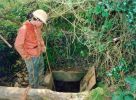
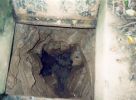 Seymour's Swallet is a tight, wet, muddy little crack and I'm constantly surprised to find myself
returning to it again and again... :) It is located near Hoarthorns
Farm just down the valley from Hoarthorns Wood Swallet and less than half a mile from Wet Sink.
The entrance pot was cleared in 1956 by the GSS and exploration was carried through to the main chamber,
where there are some unusual Limonite formations. There was a concerted amount of digging effort during
a weekend in 1961, which saw good progress in extending the cave. Further digging continued throughout
1961 & 1962 and on well into the mid-1970s by various members of the GSS and other groups. The GSS
Journals show that several members were actively digging/drilling/banging again in April/May 1984.
Seymour's Swallet is a tight, wet, muddy little crack and I'm constantly surprised to find myself
returning to it again and again... :) It is located near Hoarthorns
Farm just down the valley from Hoarthorns Wood Swallet and less than half a mile from Wet Sink.
The entrance pot was cleared in 1956 by the GSS and exploration was carried through to the main chamber,
where there are some unusual Limonite formations. There was a concerted amount of digging effort during
a weekend in 1961, which saw good progress in extending the cave. Further digging continued throughout
1961 & 1962 and on well into the mid-1970s by various members of the GSS and other groups. The GSS
Journals show that several members were actively digging/drilling/banging again in April/May 1984.
The entrance is concreted and gated but isn't locked. After being buried under a foot or so of silt, leaves
etc. in 2012, GSS re-excavated the entrance and placed a concrete ring over it to keep it clear of future
infilling. Access arrangements can be discussed via the Forest of Dean Cave Conservation and Access Group
(FoDCCAG).

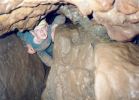
 The first picture shows Ian Clere belaying a younger Scout into the cave, while the second shows a view
looking straight down the entrance. Inside, the passageway is generally quite constricting and although
there are some more spacious sections they are few and far between. The first picture on the right shows
Neil Mason on the fixed ladder while the second and third show Chris "Soya" Foy and Chris Whitehead in
more usual scenarios. Notable features in this system are the 'Letterbox', the '90° bends', 'Cooney's
Corner' (where Nick Cooney famously got wedged), and the high aven at the end.
The first picture shows Ian Clere belaying a younger Scout into the cave, while the second shows a view
looking straight down the entrance. Inside, the passageway is generally quite constricting and although
there are some more spacious sections they are few and far between. The first picture on the right shows
Neil Mason on the fixed ladder while the second and third show Chris "Soya" Foy and Chris Whitehead in
more usual scenarios. Notable features in this system are the 'Letterbox', the '90° bends', 'Cooney's
Corner' (where Nick Cooney famously got wedged), and the high aven at the end.
Swildon's Hole
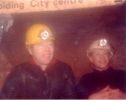 Swildon's Hole is officially one of the wettest caves in Britain and the water running through
it has been proved by dye-tracing to feed the famous Wookey Hole although a physical connection has not yet
been found. I have only been down it once in 1987 (which is why I look so young in the photo - I
was only 16!) but I'm hoping that I'll get to go down again soon. It is a really fun trip and a
wetsuit is essential even on a short trip - there is a great ladder climb through a waterfall and
a few opportunities to do a spot of swimming. At one point early on there are two pools one below
the other and the water makes them like natural Jacuzzis
Swildon's Hole is officially one of the wettest caves in Britain and the water running through
it has been proved by dye-tracing to feed the famous Wookey Hole although a physical connection has not yet
been found. I have only been down it once in 1987 (which is why I look so young in the photo - I
was only 16!) but I'm hoping that I'll get to go down again soon. It is a really fun trip and a
wetsuit is essential even on a short trip - there is a great ladder climb through a waterfall and
a few opportunities to do a spot of swimming. At one point early on there are two pools one below
the other and the water makes them like natural Jacuzzis
Westbury Brook
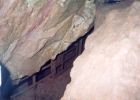
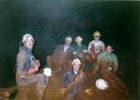 Westbury Brook is an Iron Ore Mine in the Forest of Dean and, after Otter Hole is
probably the muddiest system I have ever ventured into. There is an abundance of Red Ochre Clay
- the kind you probably had in pottery at school along with the grey stuff - and when mixed with
water this becomes really gooey and tacky.
Westbury Brook is an Iron Ore Mine in the Forest of Dean and, after Otter Hole is
probably the muddiest system I have ever ventured into. There is an abundance of Red Ochre Clay
- the kind you probably had in pottery at school along with the grey stuff - and when mixed with
water this becomes really gooey and tacky.
The entrance is tucked away at the back of a huge opening into the hillside and is gated as shown in
the first photo. It is an awkward entrance which leads down into a maze of 'passageways' all
following the vein of ore at quite a steep angle of about 50°. What follows is a mixture of huge
sports-centre sized caverns connected by some really tight muddy crawls. In one of these caverns
there is some impressive 'honeycombing' on the walls. The second photo shows Jim, Neil, Karen,
Pauline, Dave and Chris sat on a pile of muddy spoil - they were all clean before they started the
trip...
Wigpool
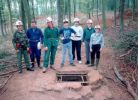
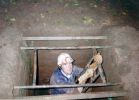 Wigpool is also an Iron Ore Mine and being only 2 miles North from Westbury Brook (see
above), has some similarities. It is muddy with the familiar red-ochre clay although the angle of the
syncline is not as steep. The main entrance has been filled long ago and there are rumours that one of
the biggest shafts was blocked when an American tank fell down it. There are four main entrances in use
today: 'Steam hole', 'Fox hole', 'Sway hole' and 'Meeks hole'. 'Steam' is so-called because on a cold
day the entrance can clearly be seen to be steaming, caused because the temperature inside the mine is
constant all year round and in winter it is often warmer underground than it is outside. Most of the
current entrances are actually old escape routes that the miners would have used in an emergency.
Whilst some surface workings date back to Roman times, the modern mine opened in 1861 and some 150,000
tons of ore were extracted before it closed in 1883. The mine reopened in 1911, and a further 7,000 tons
of ore were extracted up to 1917, with the mine officially closing for good in 1924. Access for cavers
was regained between Nov 1964 & Feb 1965 by the GSS and the mine is now a Site of Special Scientific
Interest (SSSI). All main entrances were gated and locked in 1996 and all access is now via the Forest
(RFDCC) or Gloucester (GSS) clubs. The first photo shows a party about to enter steam and the second
shows Chris descending.
Wigpool is also an Iron Ore Mine and being only 2 miles North from Westbury Brook (see
above), has some similarities. It is muddy with the familiar red-ochre clay although the angle of the
syncline is not as steep. The main entrance has been filled long ago and there are rumours that one of
the biggest shafts was blocked when an American tank fell down it. There are four main entrances in use
today: 'Steam hole', 'Fox hole', 'Sway hole' and 'Meeks hole'. 'Steam' is so-called because on a cold
day the entrance can clearly be seen to be steaming, caused because the temperature inside the mine is
constant all year round and in winter it is often warmer underground than it is outside. Most of the
current entrances are actually old escape routes that the miners would have used in an emergency.
Whilst some surface workings date back to Roman times, the modern mine opened in 1861 and some 150,000
tons of ore were extracted before it closed in 1883. The mine reopened in 1911, and a further 7,000 tons
of ore were extracted up to 1917, with the mine officially closing for good in 1924. Access for cavers
was regained between Nov 1964 & Feb 1965 by the GSS and the mine is now a Site of Special Scientific
Interest (SSSI). All main entrances were gated and locked in 1996 and all access is now via the Forest
(RFDCC) or Gloucester (GSS) clubs. The first photo shows a party about to enter steam and the second
shows Chris descending.

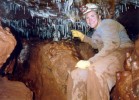 There are several levels in the mine which consist of fairly wide arch-shaped passageways, although
the lower levels are prone to flooding. A little off the 'usual' route are some really beautiful
formations, if in miniature compared to those in Otter Hole. The first picture on the right shows
me pointing at some small straws, while the second shows a pool containing some rare straw-pennants
(AKA 'crystal balls' or 'pompoms'), which are formed as the water level rises and falls, depositing
calcite on the end of stalactites (straws) that are touching the water. Apart from the formations
there are several points of interest including what remains of the stables where the pit-ponies
used to be kept, the old lift shaft and the only hand-winch in its original working position in
an Iron Ore Mine in England.
There are several levels in the mine which consist of fairly wide arch-shaped passageways, although
the lower levels are prone to flooding. A little off the 'usual' route are some really beautiful
formations, if in miniature compared to those in Otter Hole. The first picture on the right shows
me pointing at some small straws, while the second shows a pool containing some rare straw-pennants
(AKA 'crystal balls' or 'pompoms'), which are formed as the water level rises and falls, depositing
calcite on the end of stalactites (straws) that are touching the water. Apart from the formations
there are several points of interest including what remains of the stables where the pit-ponies
used to be kept, the old lift shaft and the only hand-winch in its original working position in
an Iron Ore Mine in England.
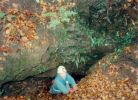
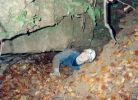 The 'Steam' & 'Foxes' routes meet not far before the first main level in the mine, which also has
access to the Meeks hole route, offering many possibilities for 'circular' trips. The two pictures
on the left show Dennis Godding and Chris Horton respectively leaving Wigpool via Foxhole. It is
possible to make high-level and lower level (water levels permitting) cross trips from Sway Hole
but, even with Sparkie's help and knowing the general area to be looking in, I have been unable
to make the connection. I first started exploring via Sway Hole in September 1998 with some of
my friends, and there are some very interesting passages and artifacts to see in that side of the mine.
The 'Steam' & 'Foxes' routes meet not far before the first main level in the mine, which also has
access to the Meeks hole route, offering many possibilities for 'circular' trips. The two pictures
on the left show Dennis Godding and Chris Horton respectively leaving Wigpool via Foxhole. It is
possible to make high-level and lower level (water levels permitting) cross trips from Sway Hole
but, even with Sparkie's help and knowing the general area to be looking in, I have been unable
to make the connection. I first started exploring via Sway Hole in September 1998 with some of
my friends, and there are some very interesting passages and artifacts to see in that side of the mine.
Links
Back to the "about me" page
Back to the main page

 Brinchcombe
Limestone Level is a small system near Ruspidge in the Forest of Dean and is perfectly suited for 'first-time'
and young cavers with a complete exploration taking a maximum of an hour and a half. The small entrance opens into
a short tunnel ending in a squeeze leading into the main system which consists of 1 main tunnel between 1 and 2
metres high and approximately 400m long. There is a 100m section of parallel passageway towards the far end of the
system which has 3 entry points but is has a sizeable amount of spoil left from the mining operation. There is a
vertical shaft leading up to the surface about halfway along the system which the miners could have used to access
the mine and which would also have provided some ventilation. It is possible to abseil down into the system via the
shaft but climbing up it is not recommended without ropes from the surface as some parts are very loose. Care should
be taken not to cross any taped sections and avoid any loose material on the walls/ceilings.
Brinchcombe
Limestone Level is a small system near Ruspidge in the Forest of Dean and is perfectly suited for 'first-time'
and young cavers with a complete exploration taking a maximum of an hour and a half. The small entrance opens into
a short tunnel ending in a squeeze leading into the main system which consists of 1 main tunnel between 1 and 2
metres high and approximately 400m long. There is a 100m section of parallel passageway towards the far end of the
system which has 3 entry points but is has a sizeable amount of spoil left from the mining operation. There is a
vertical shaft leading up to the surface about halfway along the system which the miners could have used to access
the mine and which would also have provided some ventilation. It is possible to abseil down into the system via the
shaft but climbing up it is not recommended without ropes from the surface as some parts are very loose. Care should
be taken not to cross any taped sections and avoid any loose material on the walls/ceilings.




 The first picture shows a party of Scouts entering the cave while the second shows Sparkie in the squeeze. The third
photo shows Robert Booth coming down a shaft near the 'pipe shaft' which we used to use for laddering practice, while
the forth shows Neil and Steven in the '2nd pipe shaft'. The system offers a variety of shapes and sizes of passage
ways and 'churns' (excavated caverns). There are a few natural formations but the most interesting features are the
items of miners' equipment left in the mine such as sleepers and rails in places, from the old ore-truck tramway.
Other noteable features in this system include, 'the squeeze', 'knob' rock, 'matchstick' rock, 'pop' rock, the 'pipe
shaft' and '2nd pipe shaft', the 'cathedral', and in one place there is an area containing hundreds of clay models
that successive visitors have left, myself included, there's even a miniature Stonehenge!
The first picture shows a party of Scouts entering the cave while the second shows Sparkie in the squeeze. The third
photo shows Robert Booth coming down a shaft near the 'pipe shaft' which we used to use for laddering practice, while
the forth shows Neil and Steven in the '2nd pipe shaft'. The system offers a variety of shapes and sizes of passage
ways and 'churns' (excavated caverns). There are a few natural formations but the most interesting features are the
items of miners' equipment left in the mine such as sleepers and rails in places, from the old ore-truck tramway.
Other noteable features in this system include, 'the squeeze', 'knob' rock, 'matchstick' rock, 'pop' rock, the 'pipe
shaft' and '2nd pipe shaft', the 'cathedral', and in one place there is an area containing hundreds of clay models
that successive visitors have left, myself included, there's even a miniature Stonehenge!














